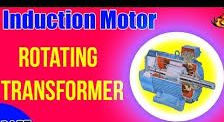Induction motor as a rotating transformer: The rotor of the squirrel cage induction motor is short-circuited by end rings. When a three-phase supply is fed to the stator of a three-phase induction motor, rotating magnetic flux is produced, and the flux gets linked to the rotor conductor. End rings short-circuit the rotor conductors, and the current starts flowing in the rotor conductor. Due to an interaction of the main flux and the rotor current, torque is produced.

In a transformer, the AC supply is fed to the primary, and the flux produced travels through the magnetic core and gets linked to the secondary of the transformer. The air gap is absent in the transformer, whereas the induction motor has an air gap. The nature of the flux produced in the transformer is pulsating type, whereas the flux produced in the stator of the induction motor is of rotating type.
The working principle of induction motors and transformers is based on Faraday’s and Lenz’s law of electromagnetic induction. If we compare the transformer with the slip-ring induction motor, the voltage induced in the rotor across slip rings under slip rings’ open condition is according to the turns ratio of the induction motor. The voltage induced across the slip ring is analogous to the secondary terminal voltage of the transformer.
The only difference between a transformer and an induction motor is that the secondary winding of the induction motor or rotor part of the induction motor is free to move or rotate. In contrast, the secondary and primary winding are firmly fixed in a position in a transformer.
The stator winding of the induction motor is placed 120 degrees electric apart to produce a rotating magnetic field. In contrast, the winding of the transformer is usually arranged concentrically around the core limb. The turns ratio of the transformer governs the voltage induced in the secondary of the transformer, and the voltage induced in the rotor winding is governed by the turns ratio of the stator to the rotor and the relative speed between synchronous speed and the motor’s actual speed.
The transformer does not have an air gap. But the induction motor has an air gap for its operation. Without an air gap, motor rotation is not possible. Therefore, an air gap is kept in the motor.
That is why Induction Motor is called Rotating Transformer.
1 thought on “Why Induction Motor is called Rotating Transformer?”